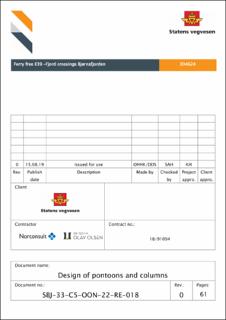Design of pontoons and columns
Abstract
Finite element models of two typical pontoon and column geometries have been developed.
Both linear and non-linear finite element models are created.
The ULS utilization and ALS utilization of both pontoon geometries studied have been found
acceptable.
The long column analyzed will collapse due to ship impact. However, this is a preferred
collapse mechanism. The upper part of the long column will act as a weak link. The bridge
girder connection will be designed to carry higher loading than the upper part of the column.
If a ship impact occurs, the destroyed pontoon and column structures can easily be replaced
because the bridge girder remains intact.
The short column is highly utilized in the ALS condition. Permanent damage in the bridge
girder intersection area cannot be ruled out if not a similar “stronger than column bridge
girder connection” is introduced in the same fashion that will be present for the long column.
The FLS methodology that can be used for finding fatigue utilization based on shell modelling
is described, but a fatigue shell model should be part of a complete global model analysis to
obtain reliable fatigue results. Fatigue analyses will be carried out in the next phase of the
project. Highest fatigue utilization is expected to be present in the column-pontoon
intersection area which is the same area that show highest ULS stresses. The column-bridge
girder intersection area may also have substantial fatigue damage, but this fatigue utilization
will be documented in other reports.

